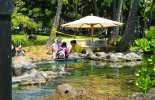The Waikiki Aquarium is located on the shores of Kapiolani Beach Park, near the Honolulu Zoo, and within walking distance of Waikiki Beach.
There is a lot to see in this area, so plan a day trip or two to visit all of the local sights including Diamond Head Crater. Founded in 1904, the Aquarium is the second oldest in the U.S., and with over 3,500 organisms from 490 species on exhibit, it gives the visitor a unique opportunity to get a close look at some unique and endangered marine life such as living coral, jellyfish, reef sharks, and green sea turtles. The Aquarium originally opened with 35 tanks and 400 marine organisms and was considered state of the art at the time. In 1919 the University of Hawaii took over the administration of the facility. It was in 1955 that the Aquarium moved to its present location and new buildings were constructed. Since then, many new programs and features have been added, including the living coral propagation program for which the place is now world-renowned. Its 110th anniversary year in 2014 is seeing it undergo further improvements and additions.
The most significant addition has been the Green Sea Turtle exhibit. Hawaiian Green Sea Turtles are a threatened species. When young turtles hatch in the wild, they make their way to the sea where they drift with the ocean currents for years before returning to the coastlines. At the Waikiki Aquarium, the turtles are fed a high-fat diet so that they grow more quickly and can then be released into the ocean at a larger size, which increases their chances of survival.
The Hawaiian Monk Seal is one of the most critically endangered seal species in the world and is only found in the Hawaiian Islands. Its primary habitat is northwest of Kauai and extends to a chain of uninhabited islands. Only about 1,200 animals remain. The Waikiki Aquarium houses two male monk seals, named Ho’ailona and Maka onaona. They were rescued as pups and would not be able to survive in the wild.

Check out Waikiki Aquarium's Hawaiian Monk Seal Habitat
Another interesting exhibit is the Giant Clams. The outdoor display shows a variety of species with an array of iridescent colors. There are only eight known species of giant clam; one of the rare varieties reaches lengths of over three feet and weighs 500 pounds. The clams in the Aquarium exhibit were grown on aquaculture farms and not taken from the ocean. Other exhibits include Marine Protected Areas and Conservation, and a unique Coral Farm. There are many interesting tropical fish to see including surgeonfishes, parrotfishes, sharks and rays, seahorses, and seadragons, as well as the Hawaiian state fish: with its incredibly long name, humuhumunukunukuapuaa. At the Waikiki Aquarium, their mission is ‘to inspire and promote understanding, appreciation, and conservation of Pacific marine life’. 330,000 people visit the aquarium yearly, and there are a number of educational activities and programs, such as community group and school visits, nighttime reef exploration activities, family nights, and annual events like the International Koi Show.
Open 9am-4:30pm daily, except Christmas Day. Open 9am-3pm on Thanksgiving Day. Open at 11am on New Years Day. Admission: $12.00 for Adults, $5.00 for Youths (13-17 years), $5.00 for Juniors (4 - 12years), Children 3 and under are Free.Admission includes an audio guide, which is quite informative. Allow a couple of hours for the full experience. Phone: (808) 923 9741
Directions: Take Kalakaua toward the Honolulu Zoo. After you cross Kapahulu get in the right lane and the Waikiki Aquarium will be on the right. Parking is available through metered street parking on the left-hand (park) side of Kalakaua Ave. A limited number of free parking stalls are located in front of the Waikiki Aquarium entrance. Those stalls are available only to visitors of the Waikiki Aquarium. Parking passes for two hours are available at the admission desk on busy days.
FREE 2025 DOWNLOADS
Oahu Intro Visitor Guide
+ Our Summary Guidesheet!
Includes the top must-see & do attractions, best times to visit, a monthly weather & visitor summary, and our tips on how to save when booking your car rental, tours, and activities. Plus, grab our free Oahu Summary Guidesheets.

The great diversity of marine life at the Waikiki Aquarium











